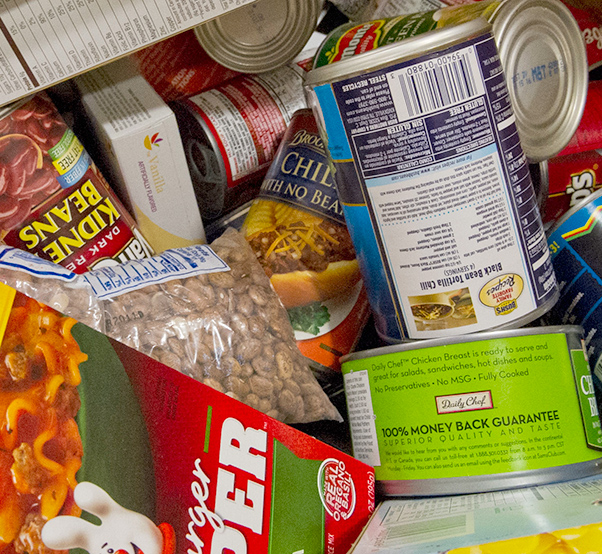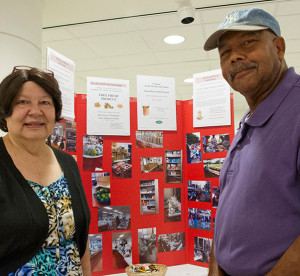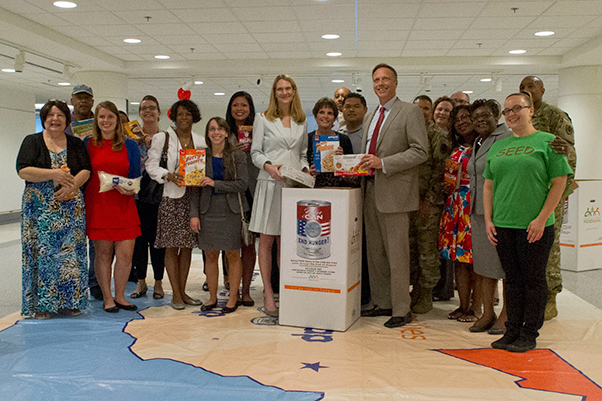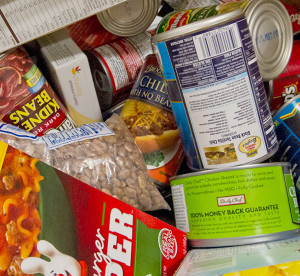Diane Carter and her husband, William Carter, explain how the Bread of Life Food Pantry benefits from the Feds Feeding Families campaign during a charity fair at the Pentagon, Aug. 23, 2016.
Diane Carter remembers what it was like to go hungry.
“There were many times that we would go without just to feed the kids,” Carter said at the Pentagon today at a charity fair for the Feds Feed Families initiative. “And at one point in time … I had sold everything in my house, all my furniture and everything, just to feed the kids.
“We were eating biscuits and beans and I was on welfare, because my previous husband had died,” she continued. “We were struggling. We know. We’ve been there.”
Eventually, the situation turned around for Carter and her now-husband William. They obtained good jobs and retired. Now they spend their days as full-time volunteers at the Bread of Life Food Pantry in Manassas, Virginia.
The Carters were at the Pentagon telling federal employees about how the pantry benefits from the Feds Feed Families campaign, a governmentwide initiative that kicked off June 1 and runs through the end of this month.
Important initiative
The campaign collects nonperishable food items to help food banks during the summer, when donations usually decrease but need tends to increase, according to the Department of Agriculture, which is leading the annual effort.
The food drive has collected nearly 57.2 million pounds of food since 2009. Last year, more than 17.9 million pounds were donated across the federal government.
Todd A. Weiler, the assistant secretary of defense for manpower and reserve affairs, stopped by and thanked the participants for all they are doing to help those in need. His hope, he said, is for the donations from the Defense Department to top last year’s contribution of more than 3.2 million pounds.
Todd A. Weiler, assistant secretary of defense for manpower and reserve affairs, poses with federal workers and charity representatives at the Feds Feeding Families charity fair at the Pentagon, Aug. 23, 2016.
“I am so impressed by the work that’s being done here,” he said. “I want to thank everyone for participating in this effort. Feds Feed Families is a very important program across the federal government, but I think even more so here in the Department of Defense.”
It is vital that DoD helps, he said, because the communities in need are the same ones that give their sons and daughters for service in the military. “I think it’s very important that we continue that communication, that linkage, with our communities across the nation,” he added.
Every donation helps
After placing a food donation in a collection box, DOD employee Naniece Shields said she is happy to give and proud to work for an agency that helps others.
“I know it’s the right thing to do. A lot of people do go hungry,” Shields said. “There are a lot of kids out here who do go hungry at night, so I just felt it was my duty.”
Shields, whose donation today included canned food, dry goods and juice, said she has been buying and donating nonperishable items all month, after she and her gym class were encouraged by the instructor to participate. “The purpose is to help feed families and to stop hunger in America,” she said.
The donations in the metro Washington area are distributed to local food banks by the Capital Area Food Bank.
Food donations fill a box at the charity fair for the Feds Feed Families initiative at the Pentagon, Aug. 23, 2016.
Linda Patterson is the executive director with Lorton Community Action Center in Lorton, Virginia, which is a partner agency with the Capital Area Food Bank and receives donations from the Feds Feed Families food drive.
Donations are critical to the operation, Patterson said. “We serve 210 families a week through our food pantry and it wouldn’t be possible without our partnership with the Capital Area Food Bank,” she said.
Randy Eller, the deputy director of logistics for the Defense Commissary Agency, was on hand to assist authorized commissary patrons in purchasing food packages that will be assembled and distributed. “Every commissary that we have within the United States has donation boxes and serves as a collection point for every installation,” he said.
Eller said he is always impressed and amazed at the generosity of those who participate.
“This program is just fantastic — it generates hundreds of thousands of pounds of donations every year, so we are proud to assist,” he said.
700,000 at risk in the D.C. area
With its wealthy areas, it might be easy for people to think that hunger does not exist in the metro Washington area, according to Holly Prater with the Capital Area Food Bank.
She said 700,000 residents in the local Washington area — 16 percent of the region — are at risk of hunger. “They don’t know where their next meal is going to be coming from,” she said.
Prater is grateful for the support from the federal government. “It’s amazing. This is one of our biggest food drives of the year. The food really helps,” she said.







